UTS 70211 Contracts Autumn 2019: Contract Law Formation Analysis
VerifiedAdded on 2023/01/16
|5
|2028
|87
Homework Assignment
AI Summary
This assignment analyzes a contract law problem involving Fern, Sarah, and Jane. Part A examines the formation of a contract, focusing on offer, acceptance, consideration, and intention to create legal relations. It concludes that no contract was formed due to a lack of valuable consideration and intention. Part B addresses a revised contract, analyzing whether the revised agreement is valid considering the principle of pre-existing duty and the practical benefit derived by the parties. The analysis considers case laws like Stilk v Myrick, Williams v Roffey, and Musumeci v Winadell to determine if the revised contract is legally binding, concluding that the revised contract is valid and Sarah & Jane must pay Fern the increased fee. The assignment also includes a bibliography of the sources used.
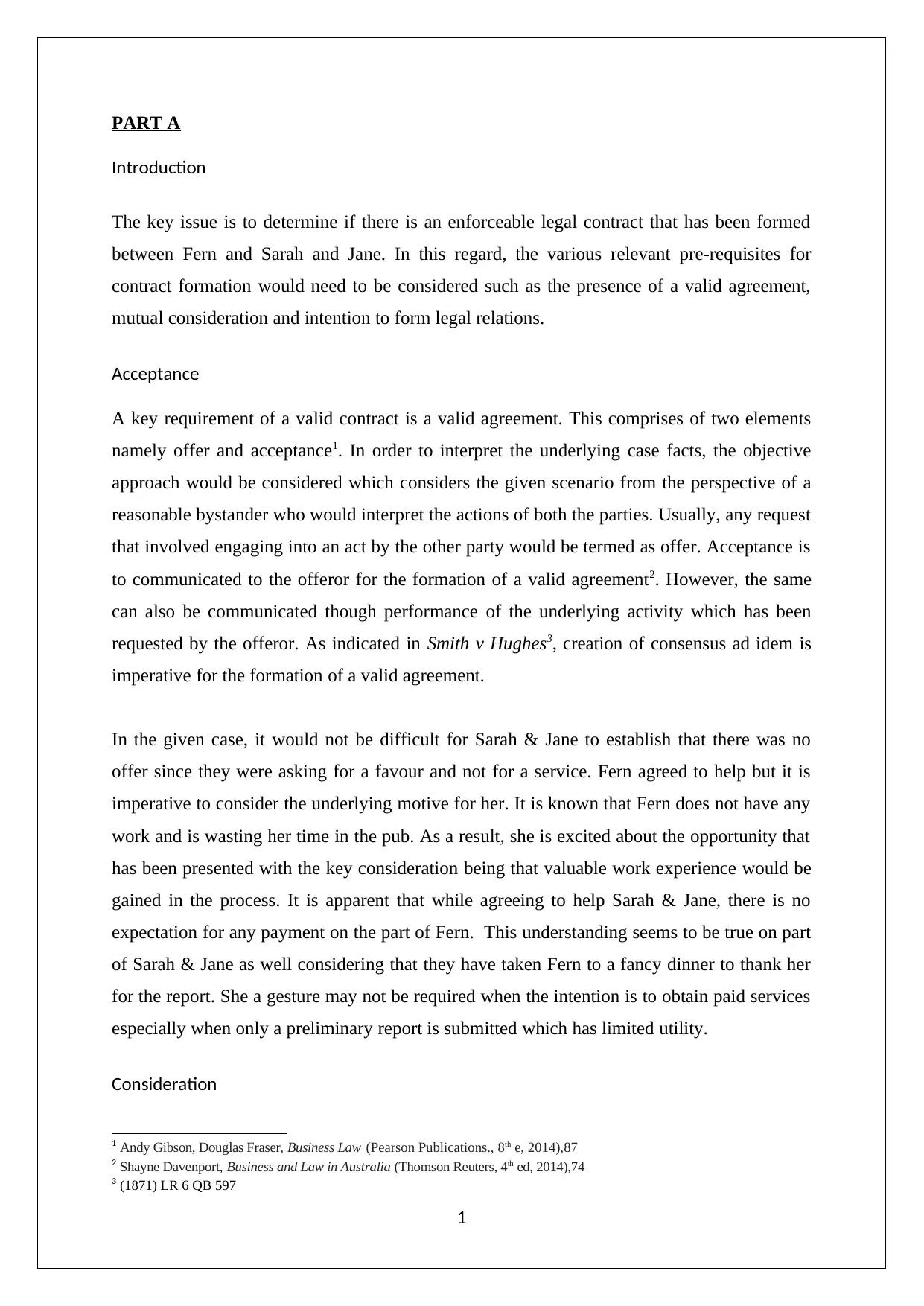
PART A
Introduction
The key issue is to determine if there is an enforceable legal contract that has been formed
between Fern and Sarah and Jane. In this regard, the various relevant pre-requisites for
contract formation would need to be considered such as the presence of a valid agreement,
mutual consideration and intention to form legal relations.
Acceptance
A key requirement of a valid contract is a valid agreement. This comprises of two elements
namely offer and acceptance1. In order to interpret the underlying case facts, the objective
approach would be considered which considers the given scenario from the perspective of a
reasonable bystander who would interpret the actions of both the parties. Usually, any request
that involved engaging into an act by the other party would be termed as offer. Acceptance is
to communicated to the offeror for the formation of a valid agreement2. However, the same
can also be communicated though performance of the underlying activity which has been
requested by the offeror. As indicated in Smith v Hughes3, creation of consensus ad idem is
imperative for the formation of a valid agreement.
In the given case, it would not be difficult for Sarah & Jane to establish that there was no
offer since they were asking for a favour and not for a service. Fern agreed to help but it is
imperative to consider the underlying motive for her. It is known that Fern does not have any
work and is wasting her time in the pub. As a result, she is excited about the opportunity that
has been presented with the key consideration being that valuable work experience would be
gained in the process. It is apparent that while agreeing to help Sarah & Jane, there is no
expectation for any payment on the part of Fern. This understanding seems to be true on part
of Sarah & Jane as well considering that they have taken Fern to a fancy dinner to thank her
for the report. She a gesture may not be required when the intention is to obtain paid services
especially when only a preliminary report is submitted which has limited utility.
Consideration
1 Andy Gibson, Douglas Fraser, Business Law (Pearson Publications., 8th e, 2014),87
2 Shayne Davenport, Business and Law in Australia (Thomson Reuters, 4th ed, 2014),74
3 (1871) LR 6 QB 597
1
Introduction
The key issue is to determine if there is an enforceable legal contract that has been formed
between Fern and Sarah and Jane. In this regard, the various relevant pre-requisites for
contract formation would need to be considered such as the presence of a valid agreement,
mutual consideration and intention to form legal relations.
Acceptance
A key requirement of a valid contract is a valid agreement. This comprises of two elements
namely offer and acceptance1. In order to interpret the underlying case facts, the objective
approach would be considered which considers the given scenario from the perspective of a
reasonable bystander who would interpret the actions of both the parties. Usually, any request
that involved engaging into an act by the other party would be termed as offer. Acceptance is
to communicated to the offeror for the formation of a valid agreement2. However, the same
can also be communicated though performance of the underlying activity which has been
requested by the offeror. As indicated in Smith v Hughes3, creation of consensus ad idem is
imperative for the formation of a valid agreement.
In the given case, it would not be difficult for Sarah & Jane to establish that there was no
offer since they were asking for a favour and not for a service. Fern agreed to help but it is
imperative to consider the underlying motive for her. It is known that Fern does not have any
work and is wasting her time in the pub. As a result, she is excited about the opportunity that
has been presented with the key consideration being that valuable work experience would be
gained in the process. It is apparent that while agreeing to help Sarah & Jane, there is no
expectation for any payment on the part of Fern. This understanding seems to be true on part
of Sarah & Jane as well considering that they have taken Fern to a fancy dinner to thank her
for the report. She a gesture may not be required when the intention is to obtain paid services
especially when only a preliminary report is submitted which has limited utility.
Consideration
1 Andy Gibson, Douglas Fraser, Business Law (Pearson Publications., 8th e, 2014),87
2 Shayne Davenport, Business and Law in Australia (Thomson Reuters, 4th ed, 2014),74
3 (1871) LR 6 QB 597
1
Paraphrase This Document
Need a fresh take? Get an instant paraphrase of this document with our AI Paraphraser
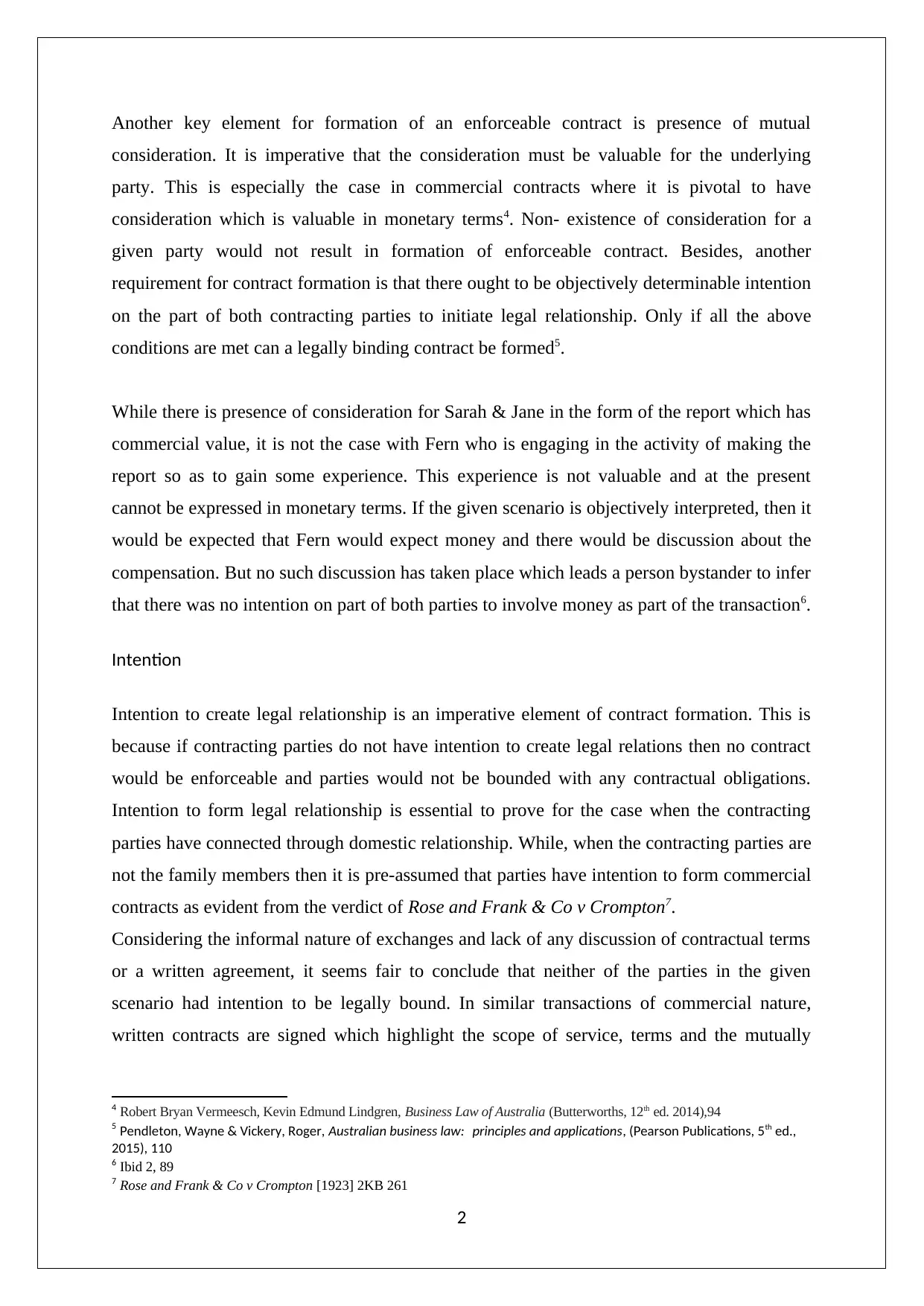
Another key element for formation of an enforceable contract is presence of mutual
consideration. It is imperative that the consideration must be valuable for the underlying
party. This is especially the case in commercial contracts where it is pivotal to have
consideration which is valuable in monetary terms4. Non- existence of consideration for a
given party would not result in formation of enforceable contract. Besides, another
requirement for contract formation is that there ought to be objectively determinable intention
on the part of both contracting parties to initiate legal relationship. Only if all the above
conditions are met can a legally binding contract be formed5.
While there is presence of consideration for Sarah & Jane in the form of the report which has
commercial value, it is not the case with Fern who is engaging in the activity of making the
report so as to gain some experience. This experience is not valuable and at the present
cannot be expressed in monetary terms. If the given scenario is objectively interpreted, then it
would be expected that Fern would expect money and there would be discussion about the
compensation. But no such discussion has taken place which leads a person bystander to infer
that there was no intention on part of both parties to involve money as part of the transaction6.
Intention
Intention to create legal relationship is an imperative element of contract formation. This is
because if contracting parties do not have intention to create legal relations then no contract
would be enforceable and parties would not be bounded with any contractual obligations.
Intention to form legal relationship is essential to prove for the case when the contracting
parties have connected through domestic relationship. While, when the contracting parties are
not the family members then it is pre-assumed that parties have intention to form commercial
contracts as evident from the verdict of Rose and Frank & Co v Crompton7.
Considering the informal nature of exchanges and lack of any discussion of contractual terms
or a written agreement, it seems fair to conclude that neither of the parties in the given
scenario had intention to be legally bound. In similar transactions of commercial nature,
written contracts are signed which highlight the scope of service, terms and the mutually
4 Robert Bryan Vermeesch, Kevin Edmund Lindgren, Business Law of Australia (Butterworths, 12th ed. 2014),94
5 Pendleton, Wayne & Vickery, Roger, Australian business law: principles and applications, (Pearson Publications, 5th ed.,
2015), 110
6 Ibid 2, 89
7 Rose and Frank & Co v Crompton [1923] 2KB 261
2
consideration. It is imperative that the consideration must be valuable for the underlying
party. This is especially the case in commercial contracts where it is pivotal to have
consideration which is valuable in monetary terms4. Non- existence of consideration for a
given party would not result in formation of enforceable contract. Besides, another
requirement for contract formation is that there ought to be objectively determinable intention
on the part of both contracting parties to initiate legal relationship. Only if all the above
conditions are met can a legally binding contract be formed5.
While there is presence of consideration for Sarah & Jane in the form of the report which has
commercial value, it is not the case with Fern who is engaging in the activity of making the
report so as to gain some experience. This experience is not valuable and at the present
cannot be expressed in monetary terms. If the given scenario is objectively interpreted, then it
would be expected that Fern would expect money and there would be discussion about the
compensation. But no such discussion has taken place which leads a person bystander to infer
that there was no intention on part of both parties to involve money as part of the transaction6.
Intention
Intention to create legal relationship is an imperative element of contract formation. This is
because if contracting parties do not have intention to create legal relations then no contract
would be enforceable and parties would not be bounded with any contractual obligations.
Intention to form legal relationship is essential to prove for the case when the contracting
parties have connected through domestic relationship. While, when the contracting parties are
not the family members then it is pre-assumed that parties have intention to form commercial
contracts as evident from the verdict of Rose and Frank & Co v Crompton7.
Considering the informal nature of exchanges and lack of any discussion of contractual terms
or a written agreement, it seems fair to conclude that neither of the parties in the given
scenario had intention to be legally bound. In similar transactions of commercial nature,
written contracts are signed which highlight the scope of service, terms and the mutually
4 Robert Bryan Vermeesch, Kevin Edmund Lindgren, Business Law of Australia (Butterworths, 12th ed. 2014),94
5 Pendleton, Wayne & Vickery, Roger, Australian business law: principles and applications, (Pearson Publications, 5th ed.,
2015), 110
6 Ibid 2, 89
7 Rose and Frank & Co v Crompton [1923] 2KB 261
2
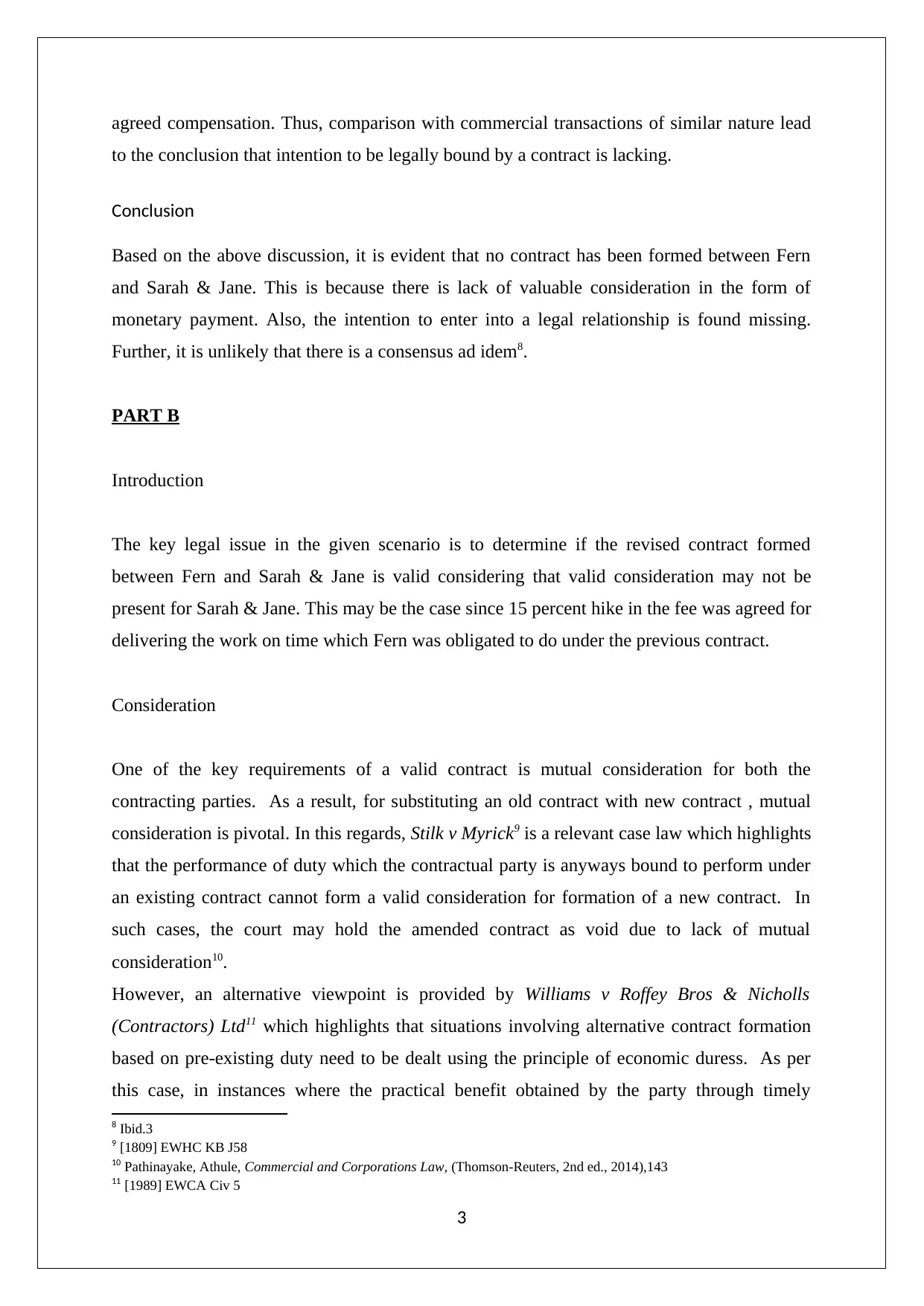
agreed compensation. Thus, comparison with commercial transactions of similar nature lead
to the conclusion that intention to be legally bound by a contract is lacking.
Conclusion
Based on the above discussion, it is evident that no contract has been formed between Fern
and Sarah & Jane. This is because there is lack of valuable consideration in the form of
monetary payment. Also, the intention to enter into a legal relationship is found missing.
Further, it is unlikely that there is a consensus ad idem8.
PART B
Introduction
The key legal issue in the given scenario is to determine if the revised contract formed
between Fern and Sarah & Jane is valid considering that valid consideration may not be
present for Sarah & Jane. This may be the case since 15 percent hike in the fee was agreed for
delivering the work on time which Fern was obligated to do under the previous contract.
Consideration
One of the key requirements of a valid contract is mutual consideration for both the
contracting parties. As a result, for substituting an old contract with new contract , mutual
consideration is pivotal. In this regards, Stilk v Myrick9 is a relevant case law which highlights
that the performance of duty which the contractual party is anyways bound to perform under
an existing contract cannot form a valid consideration for formation of a new contract. In
such cases, the court may hold the amended contract as void due to lack of mutual
consideration10.
However, an alternative viewpoint is provided by Williams v Roffey Bros & Nicholls
(Contractors) Ltd11 which highlights that situations involving alternative contract formation
based on pre-existing duty need to be dealt using the principle of economic duress. As per
this case, in instances where the practical benefit obtained by the party through timely
8 Ibid.3
9 [1809] EWHC KB J58
10 Pathinayake, Athule, Commercial and Corporations Law, (Thomson-Reuters, 2nd ed., 2014),143
11 [1989] EWCA Civ 5
3
to the conclusion that intention to be legally bound by a contract is lacking.
Conclusion
Based on the above discussion, it is evident that no contract has been formed between Fern
and Sarah & Jane. This is because there is lack of valuable consideration in the form of
monetary payment. Also, the intention to enter into a legal relationship is found missing.
Further, it is unlikely that there is a consensus ad idem8.
PART B
Introduction
The key legal issue in the given scenario is to determine if the revised contract formed
between Fern and Sarah & Jane is valid considering that valid consideration may not be
present for Sarah & Jane. This may be the case since 15 percent hike in the fee was agreed for
delivering the work on time which Fern was obligated to do under the previous contract.
Consideration
One of the key requirements of a valid contract is mutual consideration for both the
contracting parties. As a result, for substituting an old contract with new contract , mutual
consideration is pivotal. In this regards, Stilk v Myrick9 is a relevant case law which highlights
that the performance of duty which the contractual party is anyways bound to perform under
an existing contract cannot form a valid consideration for formation of a new contract. In
such cases, the court may hold the amended contract as void due to lack of mutual
consideration10.
However, an alternative viewpoint is provided by Williams v Roffey Bros & Nicholls
(Contractors) Ltd11 which highlights that situations involving alternative contract formation
based on pre-existing duty need to be dealt using the principle of economic duress. As per
this case, in instances where the practical benefit obtained by the party through timely
8 Ibid.3
9 [1809] EWHC KB J58
10 Pathinayake, Athule, Commercial and Corporations Law, (Thomson-Reuters, 2nd ed., 2014),143
11 [1989] EWCA Civ 5
3
⊘ This is a preview!⊘
Do you want full access?
Subscribe today to unlock all pages.

Trusted by 1+ million students worldwide
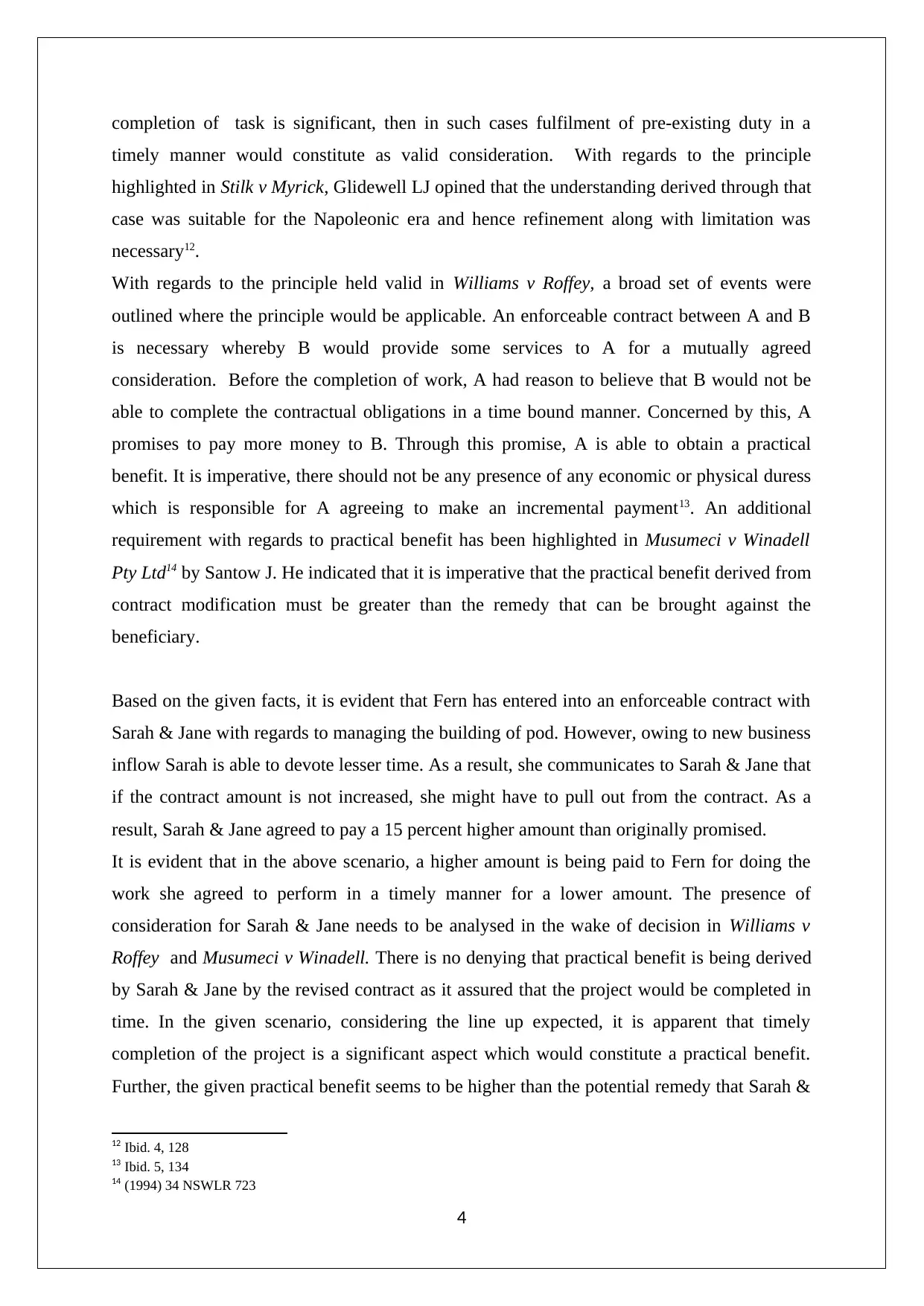
completion of task is significant, then in such cases fulfilment of pre-existing duty in a
timely manner would constitute as valid consideration. With regards to the principle
highlighted in Stilk v Myrick, Glidewell LJ opined that the understanding derived through that
case was suitable for the Napoleonic era and hence refinement along with limitation was
necessary12.
With regards to the principle held valid in Williams v Roffey, a broad set of events were
outlined where the principle would be applicable. An enforceable contract between A and B
is necessary whereby B would provide some services to A for a mutually agreed
consideration. Before the completion of work, A had reason to believe that B would not be
able to complete the contractual obligations in a time bound manner. Concerned by this, A
promises to pay more money to B. Through this promise, A is able to obtain a practical
benefit. It is imperative, there should not be any presence of any economic or physical duress
which is responsible for A agreeing to make an incremental payment13. An additional
requirement with regards to practical benefit has been highlighted in Musumeci v Winadell
Pty Ltd14 by Santow J. He indicated that it is imperative that the practical benefit derived from
contract modification must be greater than the remedy that can be brought against the
beneficiary.
Based on the given facts, it is evident that Fern has entered into an enforceable contract with
Sarah & Jane with regards to managing the building of pod. However, owing to new business
inflow Sarah is able to devote lesser time. As a result, she communicates to Sarah & Jane that
if the contract amount is not increased, she might have to pull out from the contract. As a
result, Sarah & Jane agreed to pay a 15 percent higher amount than originally promised.
It is evident that in the above scenario, a higher amount is being paid to Fern for doing the
work she agreed to perform in a timely manner for a lower amount. The presence of
consideration for Sarah & Jane needs to be analysed in the wake of decision in Williams v
Roffey and Musumeci v Winadell. There is no denying that practical benefit is being derived
by Sarah & Jane by the revised contract as it assured that the project would be completed in
time. In the given scenario, considering the line up expected, it is apparent that timely
completion of the project is a significant aspect which would constitute a practical benefit.
Further, the given practical benefit seems to be higher than the potential remedy that Sarah &
12 Ibid. 4, 128
13 Ibid. 5, 134
14 (1994) 34 NSWLR 723
4
timely manner would constitute as valid consideration. With regards to the principle
highlighted in Stilk v Myrick, Glidewell LJ opined that the understanding derived through that
case was suitable for the Napoleonic era and hence refinement along with limitation was
necessary12.
With regards to the principle held valid in Williams v Roffey, a broad set of events were
outlined where the principle would be applicable. An enforceable contract between A and B
is necessary whereby B would provide some services to A for a mutually agreed
consideration. Before the completion of work, A had reason to believe that B would not be
able to complete the contractual obligations in a time bound manner. Concerned by this, A
promises to pay more money to B. Through this promise, A is able to obtain a practical
benefit. It is imperative, there should not be any presence of any economic or physical duress
which is responsible for A agreeing to make an incremental payment13. An additional
requirement with regards to practical benefit has been highlighted in Musumeci v Winadell
Pty Ltd14 by Santow J. He indicated that it is imperative that the practical benefit derived from
contract modification must be greater than the remedy that can be brought against the
beneficiary.
Based on the given facts, it is evident that Fern has entered into an enforceable contract with
Sarah & Jane with regards to managing the building of pod. However, owing to new business
inflow Sarah is able to devote lesser time. As a result, she communicates to Sarah & Jane that
if the contract amount is not increased, she might have to pull out from the contract. As a
result, Sarah & Jane agreed to pay a 15 percent higher amount than originally promised.
It is evident that in the above scenario, a higher amount is being paid to Fern for doing the
work she agreed to perform in a timely manner for a lower amount. The presence of
consideration for Sarah & Jane needs to be analysed in the wake of decision in Williams v
Roffey and Musumeci v Winadell. There is no denying that practical benefit is being derived
by Sarah & Jane by the revised contract as it assured that the project would be completed in
time. In the given scenario, considering the line up expected, it is apparent that timely
completion of the project is a significant aspect which would constitute a practical benefit.
Further, the given practical benefit seems to be higher than the potential remedy that Sarah &
12 Ibid. 4, 128
13 Ibid. 5, 134
14 (1994) 34 NSWLR 723
4
Paraphrase This Document
Need a fresh take? Get an instant paraphrase of this document with our AI Paraphraser
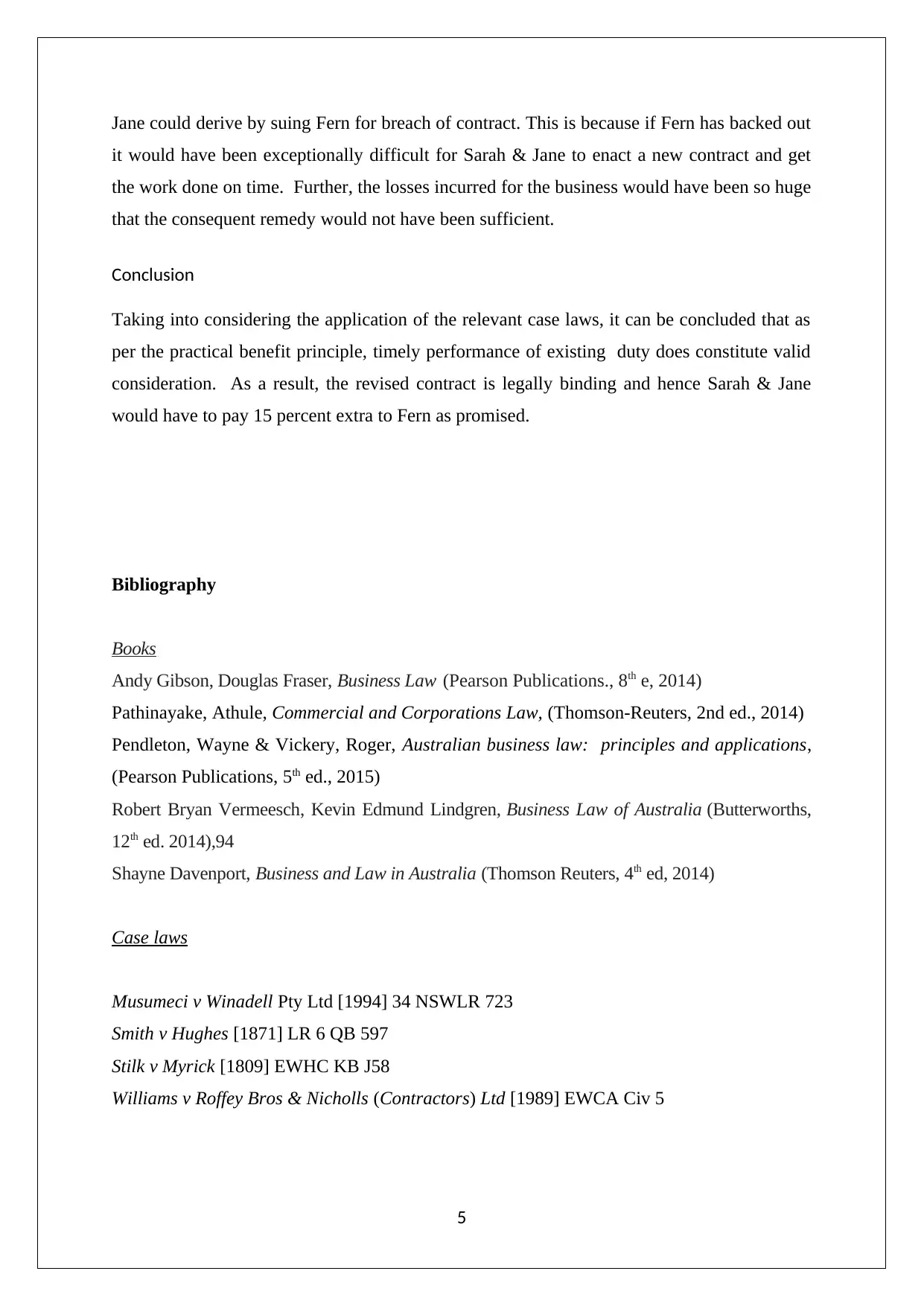
Jane could derive by suing Fern for breach of contract. This is because if Fern has backed out
it would have been exceptionally difficult for Sarah & Jane to enact a new contract and get
the work done on time. Further, the losses incurred for the business would have been so huge
that the consequent remedy would not have been sufficient.
Conclusion
Taking into considering the application of the relevant case laws, it can be concluded that as
per the practical benefit principle, timely performance of existing duty does constitute valid
consideration. As a result, the revised contract is legally binding and hence Sarah & Jane
would have to pay 15 percent extra to Fern as promised.
Bibliography
Books
Andy Gibson, Douglas Fraser, Business Law (Pearson Publications., 8th e, 2014)
Pathinayake, Athule, Commercial and Corporations Law, (Thomson-Reuters, 2nd ed., 2014)
Pendleton, Wayne & Vickery, Roger, Australian business law: principles and applications,
(Pearson Publications, 5th ed., 2015)
Robert Bryan Vermeesch, Kevin Edmund Lindgren, Business Law of Australia (Butterworths,
12th ed. 2014),94
Shayne Davenport, Business and Law in Australia (Thomson Reuters, 4th ed, 2014)
Case laws
Musumeci v Winadell Pty Ltd [1994] 34 NSWLR 723
Smith v Hughes [1871] LR 6 QB 597
Stilk v Myrick [1809] EWHC KB J58
Williams v Roffey Bros & Nicholls (Contractors) Ltd [1989] EWCA Civ 5
5
it would have been exceptionally difficult for Sarah & Jane to enact a new contract and get
the work done on time. Further, the losses incurred for the business would have been so huge
that the consequent remedy would not have been sufficient.
Conclusion
Taking into considering the application of the relevant case laws, it can be concluded that as
per the practical benefit principle, timely performance of existing duty does constitute valid
consideration. As a result, the revised contract is legally binding and hence Sarah & Jane
would have to pay 15 percent extra to Fern as promised.
Bibliography
Books
Andy Gibson, Douglas Fraser, Business Law (Pearson Publications., 8th e, 2014)
Pathinayake, Athule, Commercial and Corporations Law, (Thomson-Reuters, 2nd ed., 2014)
Pendleton, Wayne & Vickery, Roger, Australian business law: principles and applications,
(Pearson Publications, 5th ed., 2015)
Robert Bryan Vermeesch, Kevin Edmund Lindgren, Business Law of Australia (Butterworths,
12th ed. 2014),94
Shayne Davenport, Business and Law in Australia (Thomson Reuters, 4th ed, 2014)
Case laws
Musumeci v Winadell Pty Ltd [1994] 34 NSWLR 723
Smith v Hughes [1871] LR 6 QB 597
Stilk v Myrick [1809] EWHC KB J58
Williams v Roffey Bros & Nicholls (Contractors) Ltd [1989] EWCA Civ 5
5
1 out of 5
Related Documents
Your All-in-One AI-Powered Toolkit for Academic Success.
+13062052269
info@desklib.com
Available 24*7 on WhatsApp / Email
![[object Object]](/_next/static/media/star-bottom.7253800d.svg)
Unlock your academic potential
Copyright © 2020–2025 A2Z Services. All Rights Reserved. Developed and managed by ZUCOL.





